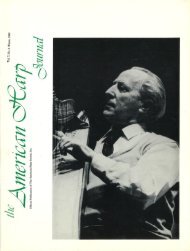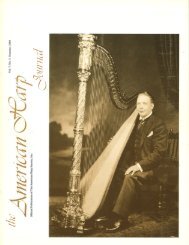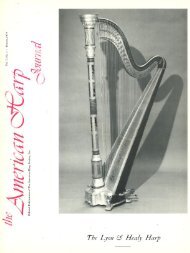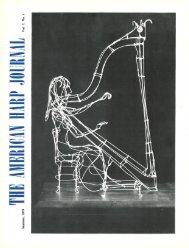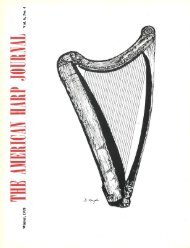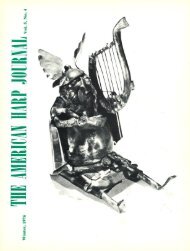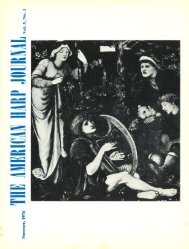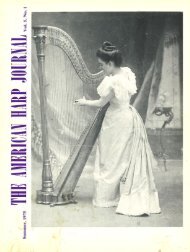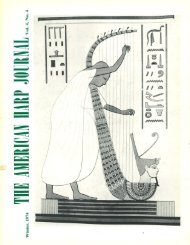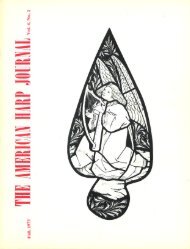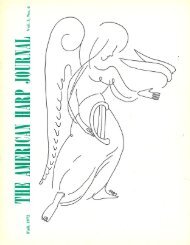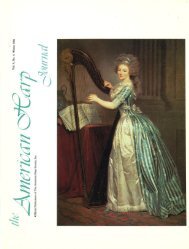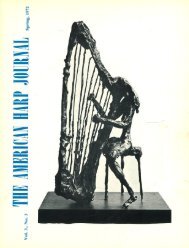AHJ, Vol. 2 No. 1, Spring 1969
AHJ, Vol. 2 No. 1, Spring 1969
AHJ, Vol. 2 No. 1, Spring 1969
You also want an ePaper? Increase the reach of your titles
YUMPU automatically turns print PDFs into web optimized ePapers that Google loves.
wrong note, and to wait for him to tell her<br />
she's playing too loudly. Rarely has a student<br />
ever told me that the conductor said<br />
she was playing too loudly.<br />
For various reasons, sightreading is a<br />
difficult thing for a beginning harpist. The<br />
part in all probability will not be marked<br />
properly for pedal movements. One must<br />
remember that the harp has seven pedals<br />
with three positions for each. Because it is<br />
sometimes impractical to move a pedal and<br />
then return it to the original position, it is<br />
necessary for the harpist to go through her<br />
part carefully, marking the pedals as they<br />
should be moved and carried over if possible.<br />
If this has not been done, it is difficult<br />
to sightread when one must also pick out<br />
notes and follow rhythm. Then too, the harp<br />
parts are often too difficult for the young<br />
harpist. She lacks the chord experience and<br />
interval feeling that it takes to sightread.<br />
When the student harpist is given a piece<br />
to sightread it is best for her to find the<br />
main entrances (possibly only one chord or<br />
one note), try to count the entire piece, and<br />
mark as many cues as possible to help her<br />
to keep her place in the music. If she does<br />
this, she will be able to play her part, given<br />
the time to learn it. However, rather than<br />
to expect a student harpist to sightread, it<br />
is much more prudent to distribute the harp<br />
parts early, with the tempos clearly indicated.<br />
Insist that the harpist learn her part<br />
as firmly as she would a solo, so that if the<br />
conductor were to stop the orchestra and ask<br />
her to play, she could-confidently. If she<br />
knows her part well initially, she will have<br />
much less difficulty in learning to follow<br />
the beat. It is also wise for the harpist to<br />
work with a metronome, not only with her<br />
playing part, but also with those difficult<br />
bars of two and three that must be counted<br />
between sections of playing, perhaps while<br />
moving as many as five or six pedals. Working<br />
with a metronome will also help her to<br />
understand where pages must be turned,<br />
pedals changed, and when to place her hands<br />
on the strings for her next entrance. A very<br />
fine idea for the harpist is to secure a recording<br />
of the piece, so that she can get an<br />
idea of where the harp part is exposed and<br />
what the tempos are; then if it is possible,<br />
to play along with the recording.<br />
Perhaps one of the best suggestions for<br />
learning how to follow a conductor is for<br />
SPRING/ <strong>1969</strong><br />
the harpist to visualize that there is a conductor<br />
in front of her when she is practicing.<br />
In this way she can develop the habit<br />
of looking up. Urge her to write in all possible<br />
cues, like "cellos" or "violins" rather<br />
than just notes. Pedal charts are an important<br />
aid. So often the conductor stops in the<br />
middle of a composition to return to a particular<br />
point, while the harpist is frantically<br />
trying to figure out where her pedals should<br />
be, especially since the harp is frequently<br />
not set up in the key that the orchestra is in.<br />
So, if a harpist can indicate all of her main<br />
entrances with pedal charts, she knows at<br />
a glance what her pedal positions are and<br />
can easily jump to any point.<br />
It is often advisable to simplify harp<br />
parts, since it is better to be able to play<br />
three or four chords confidently than to attempt<br />
a maze of notes that the harpist is<br />
incapable of playing at her level of development<br />
and technical skill. Perhaps all she can<br />
do in the beginning is play with one hand.<br />
Then, as she becomes sure of her entrances<br />
and more confident, she'll be able to add her<br />
other hand and more notes until she can<br />
play the entire part. Since the harp is often<br />
not understood at all by composers, many<br />
parts for it are not well written. Often it<br />
is necessary to re-write a part, not only so<br />
that the same effect can be brought out, but,<br />
also, so that it can be played on the instrument.<br />
The harpist should be urged to sit in on<br />
all rehearsals, since this will help her in<br />
learning how to count and will familiarize<br />
her with the musical score. As I have mentioned,<br />
the young harpist usually has little<br />
knowledge of musical notations; if she<br />
comes in at the last moment she may not<br />
realize that 3/ 8 will be beat in 1, or 6/ 8 in 2,<br />
and while the conductor is beating in 1, she<br />
will be beating in three and will be far behind<br />
by the time she is to come in. Sitting<br />
in on all 1·ehearsals also allows th harpist<br />
to hear what is being played and to enter<br />
into the composition musically rather than<br />
mathematically, as usually happens if she<br />
has attended only one or two rehearsals.<br />
Tuning the harp presents a problem for<br />
the student orchestra harpist. She must develop<br />
a fine ear and fine relative pitch. It<br />
is best for her to begin to tune her instrument<br />
to a well-tuned piano on the diatonic<br />
scale note for note, sounding middle C to<br />
5




